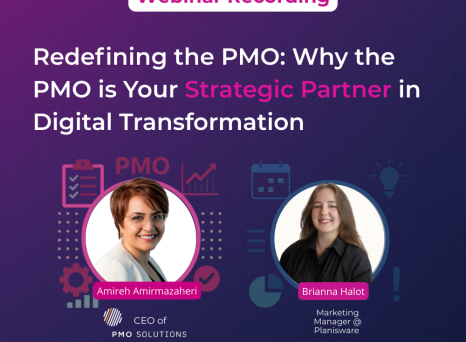A Project Management Office (PMO) is a department or group of people within an organization. It provides support around Project Management governance, frameworks, templates, tools, prioritization and reporting.
An organization may have one or multiple PMOs. They can handle a portfolio of projects or just a few, and some may even sit within a specific division. While their makeup may differ, they all have one uniting mission: to facilitate and improve project implementation.
But how exactly do they do this? And does your business really need one? Let’s explore what the PMO is, what the PMO isn’t, and how it supports your critical business functions.
Clearing Up the Acronym Confusion
The Project Management world is brimming with acronyms. Unhelpfully, most of them contain one of the 3 ‘Ps’: project, portfolio, and product.
When we write PMO, we exclusively refer to the Project and Portfolio Management Office. However, you may find some similar acronyms online, such as:
- Portfolio or Project Management Officer (PMO).
- Program Management Office (PMO).
- Product Portfolio Office (PPO).
- Portfolio Management Office (PfMO or PfO).
If you’re planning to build a PMO, be aware of these terms and their unique differences. It’s essential you communicate the right terminology and meaning to your stakeholders.
If you don’t, you may face misunderstandings down the line. For instance, your C-suite could assume your Project Management Office handles a complete portfolio of projects when it only handles one. Outlining responsibilities will clear up this confusion.
On that note…
What Is the Role of the PMO?
This isn’t an easy task, as PMOs vary from business to business. But, generally speaking, the Project and Portfolio Management Office will:
- Provide, support and control project management processes, methodologies, workflows, frameworks, deliverables and tools.
- Balance the portfolio mix, considering long-term versus short-term projects, project costs, risks and rewards, and resources required.
- Create and/or share resources, such as templates and training.
- Identify, register, and follow-up on risks. Arbitrate and communicate on the decisions taken.
- Report data, budget alignment, metrics and overall project progress to stakeholders.
- Plan and allocate resources across project teams.
- Streamline communication across teams.
- Analyze portfolio performance, gather project feedback and lessons learnt.
As the PMO matures - and it will - expect this list of responsibilities to grow.
Gartner anticipates 75% of all PMOs to evolve to a more strategic function by 2025. As such, the future role of the PMO will involve:
- Supporting stakeholders in defining and updating the strategic vision, and ensuring operational activities align with it.
- Aiding priority management by incorporating adaptative planning, resource allocation, and change request processes.
- Supporting business leaders by providing a comprehensive view of their respective roadmaps, complete with adequate measurement and communication of value-based metrics.
- Handling large project portfolios or complex projects.
- Increasing strategic alignment with business goals and objectives.
You can read more about strategic PMOs here.
A Rundown of PMO Structures
While the majority of PMOs handle similar responsibilities, the level of control they wield will differ. Many Project Management experts categorize them into 3 structures.):
- Directive PMOs. These assume direct responsibility in project management activities, such as resource management and project management. For instance, by providing and managing project managers.
- Controlling PMOs. These ensure compliance in project management activities. As such, they validate decisive steps in the project lifecycle (for example, pre-studies validation, project start, and gates validation).
- Supportive PMOs. These ****update the PPM referential by registering projects, and resources. They also provide tools and support to project/program/portfolio management teams.
Your industry, size, project needs, and maturity will determine which type of PMO you need.
What Are the Benefits of a Project Management Office?
In 2014, the German Association for Project Management and Nürtingen-Geislingen University conducted a study entitled “The PMO in Practice”. The results of the study demonstrate the benefits of setting up a Project Management Office within a company:
- 94% consider the general contribution of the PMO very significant for their company.
- 55% think a PMO avoids duplication of projects.
- 42% believe a PMO offers greater reliability to achieve strategic project targets.
To this day, companies still hold the PMO in high esteem, with 81% of professionals believing PMOs are critical to meeting programme objectives.
Through the standardization, structure and governance they deliver, Project Management Offices:
- Improve visibility into project progress. This helps to identify failures and successes, such as speed of delivery and missed deadlines.
- Gather and report on key performance indicators. This keeps stakeholders in the loop and communicates the value of projects to wider teams.
- Communicate and manage priorities across disparate teams and stakeholders. This provides better direction for Project Managers and avoids strategic misalignment.
- Monitor cost alignment. This reduces overspending and reassures stakeholders.
- Adapt resource allocation. A PMO will anticipate resourcing needs, and allocate the right people to avoid skills gaps and project delays.
- Improve maturity. PMOs can pinpoint skills shortages, provide training, and support learning and development plans. They may also flag the need to hire more staff.
All in all, the PMO not only meets project objectives but improves the maturity, value and efficiency of projects altogether.
Do You Need a PMO?
The simple answer? Yes.
But don’t jump the gun just yet.
As we stated, the role of the PMO is evolving towards a more strategic function. This is an effort to avoid misalignment between business and project teams and increase value.
Indeed, 15% of professionals believe their PMO is performing below organizational expectations. And 52% of businesses believe increasing PMO maturity is important or imperative.
While the PMO is essential for improving project delivery, its benefits can stretch far beyond this. With the right business case, planning, and metrics, you can deliver value for your stakeholders and business as a whole.
All you need to do is know how to build the right PMO for your use case.
If you’re ready to learn how, download our step-by-step guide.


